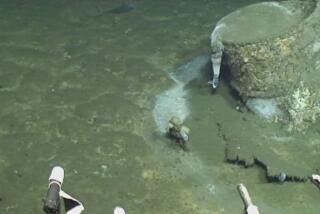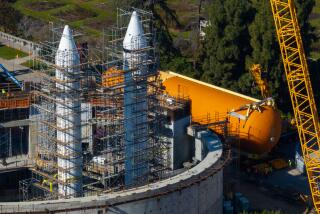Only Nose Will Know Where Molasses Vat Was
The acrid odor of sugar cane molasses still hangs in the air around the remaining shell of the cavernous tank, which once held as much as 13,500 tons of the sticky substance, shipped in from exotic Asian ports such as Bangkok and Singapore.
The tank has been empty for almost a month, but molasses that has seeped into the ground since the 1960s has left an odoriferous residue that works its way into the nostrils and throat. Soon, however, that odor will be all that is left of the molasses terminal.
After 20 years, the flow of molasses is trickling to a halt here because Cargill Inc., importer and seller of the sweet stuff, is closing its terminal and moving the operation to Los Angeles, according to a company spokesman.
The steel vat was 32 feet high before Lakeside-based Grape Sales, a steel sales company, began to dismantle it, Leonard Grape, steel merchant and owner, said.
Now half the tank has been cut into large slabs of sheet metal waiting for a forklift to stack it for transport to the Lakeside yard. The remainder will be dismantled within the week, Grape said.
The tank, on 8th Avenue at Harbor Drive, was the largest of nine owned and operated by Cargill, a family-owned grain-shipping company established in Minnesota in the 1920s, said Gerry Keller, Cargill Western Region superintendent. This tank is the only one with walls still standing. The others have been sold and carted away.
The tanks were used to hold sugar cane molasses, which is different from corn syrup molasses--the kind humans eat. Sugar cane molasses is diluted with water steeped through crushed corn, absorbing proteins and phosphorus, then sold to feed lots, feed mills, stockyards and dairy farms, Keller said.
There the molasses is mixed with alfalfa, corn, wheat or grain and fed to cows to fatten them for slaughter, Joe Rodriguez, Cargill tanker truck driver, said.
Importing and selling molasses for animal feed is a sideline of Cargill, along with meat-packing and soybean processing, Keller said.
Originally built in the 1960s by the now-defunct California Molasses Co., the tank, along with the others, was sold to Cargill in 1974, when the company decided to expand into San Diego, Keller said.
San Diego originally was considered an ideal point of departure for the molasses, which arrived in tankers and traveled through pipelines into the huge tanks, but now the company finds it more efficient to have the molasses shipped to Los Angeles, Keller said.
Cargill has relinquished its lease on the land and closed down operations at the San Diego waterfront terminal, Keller said.
All supplies and the sheet metal must be off the land by Friday, Grape said.
Grape, who bought the tank before dismantling it, said he expects to remove 160 to 170 tons of sheet metal from the site and resell it, possibly making as much as $40,000.
The sheet metal, about a quarter-inch to half-inch thick, will be used for ditch covers, base plates for building columns, steel boxes to contain materials and to line trailers, among other things, Grape said.
But before it could be cut, the metal had to be hosed down.
“The bottom was too sticky to cut and the smell was too strong for anyone to work in. Metal cutters usually want to have clean metal to work with,” Rodriguez said.
It took seven men several weeks to clean six to 10 inches of sludge by shoveling the water-diluted material to a side of the tank so it could be suctioned off into another tank for disposal in Otay Mesa, Rodriguez said. Cargill hired contractors for the work.
“I didn’t want anything to do with it,” Rodriguez said.
Cargill’s offices, the only structures that will be left on the land after next week, will be taken over by the neighboring Waterfront Service Fuel Co., Rodriguez said.
More to Read
Sign up for Essential California
The most important California stories and recommendations in your inbox every morning.
You may occasionally receive promotional content from the Los Angeles Times.










